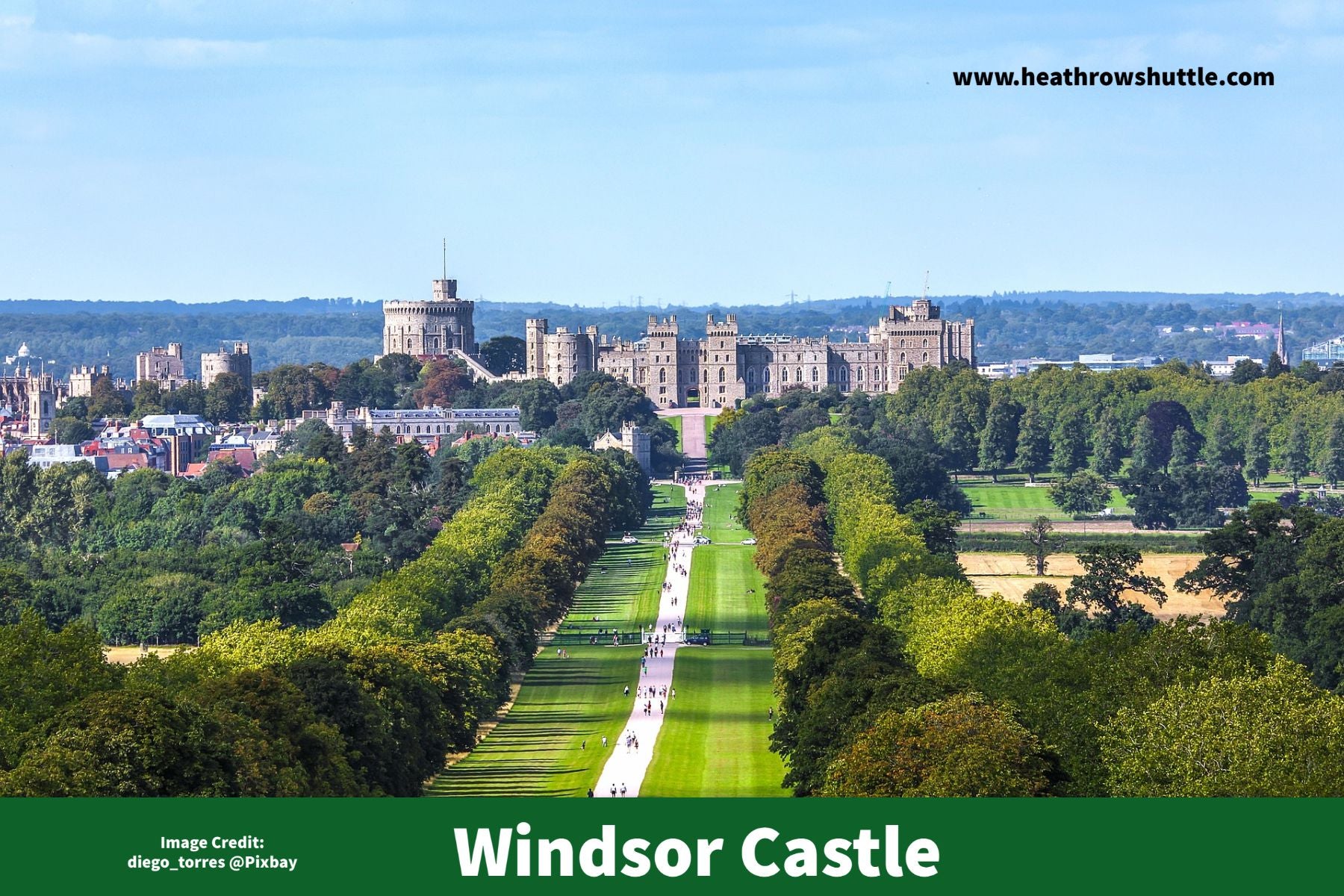
Windsor Castle
Windsor Castle is the world's oldest and biggest inhabited castle. Throughout the year, it is open to the public. It was founded in the 11th century by William the Conqueror and has since hosted 39 kings. The Queen now spends the majority of her own weekends at the Castle.
Windsor Castle has a lot to offer in terms of sights and activities. You'll see ceremonial rooms used by The Queen and members of the Royal Family today, as well as historical chambers erected for Charles II and his Queen, Catherine of Braganza, in the State Apartments.
With a few exceptions during the year when formal State activities are taking place, the State Apartments are open whenever the Castle is open.
4.6 - 42,197 Google reviews
Windsor Castle Entry Prices
|
|
|
|
Adult |
£23.50 |
|
Over 60 / Student |
£21.20 |
|
Child (5-16) / Disabled |
£13.50 |
|
Under 5 |
Free |
|
Family (2 adults and up to 3 children) |
£60.50 |
For Tickets please visit Windsor Castle Official Website
https://www.rct.uk/visit/windsor-castle (Link opens in new window)
Windsor Castle is closed on Tuesdays and Wednesdays.
|
|
Opening time |
Last admission |
Closing time |
|
1 March - 31 October |
10:00 |
16:00 |
17:15 |
|
1 November - 28 February |
10:00 |
15:00 |
16:15 |
Entrance to the State Apartments closes 30 minutes after the last admission time.
Windsor Castle closures
As Windsor Castle is a working royal palace, sometimes the entire Castle or the State Apartments within the Castle need to be closed at short notice.
- Windsor Castle will be operating with reduced opening hours on Monday, 22 November. Last entry is 13:00 and the Castle closes at 14:15
Semi-State Rooms closures
The Semi-State Rooms usually open from autumn-spring each year. The Semi-State Rooms are not open on days when the State Apartments are closed.
- The Semi-State Rooms will be closed on 4 October 2021
- The Semi-State Rooms will be closed on 19 November 2021
St George's Chapel
St George’s Chapel is open for visitors on Monday, Thursday, Friday and Saturday from 10:00 to 16:15 (last entry 16:00).
- Thursday, 23 December – Chapel closed from 13:00
- Friday, 24 December – Chapel closed from 13:00
STATE APARTMENTS - CEREMONIAL ROUTE
The ceremonial path will take you by the major State Apartments used by The Queen and other members of the Royal Family today. The Queen uses these rooms to host formal visits by Heads of State from foreign nations, as well as investitures and award ceremonies in which British men and women are recognised for their achievements.
The Grand Reception Space is perhaps the most spectacular room on the ceremonial route. It was previously the Castle's principal ballroom, with its chandeliers and gold. The huge malachite urn, gifted to Queen Victoria by Tsar Nicholas I in 1839 and one of the biggest specimens outside Russia, is a must-see in this room. It's difficult to imagine that this area was so badly destroyed in the 1992 fire, given the gold-covered walls and ceilings. The chamber was meticulously restored to its previous beauty, which may still be seen today.
George IV added the huge Waterloo Chamber (where the pantomime portraits are presently on exhibit) to the State Apartments, as well as a new set of private chambers within the Castle, the Semi-State Rooms, to commemorate Napoleon Bonaparte's defeat in 1815.
STATE APARTMENTS - HISTORIC ROUTE
The chambers erected for Charles II and his Queen, Catherine de Braganza, will be seen on the historic path.
These chambers follow a pattern that has been established in English palaces for hundreds of years: a sequence of lesser rooms leading up to the most secluded quarters. Only the most important members of the court were allowed to see the king and queen.
Charles II sought intended to match his cousin Louis XIV's exploits at Versailles in France. With painted ceilings by Antonio Verrio and sculptures by Grinling Gibbons, he modernised the Castle's interiors in the 17th century, making them the greatest State Apartments in England.
Since then, the rooms have seen substantial transformations. Under the guidance of architect Sir Jeffry Wyatville, who worked for George IV, several of the painted ceilings were covered with ornate plaster. On the ceremonial walk, you'll pass through the Grand Reception Room, which has a gilded plaster ceiling that was restored following the Windsor Castle fire.
The Royal Collection's best works of art, including paintings by Holbein, Van Dyck, and Rubens, are shown in the State Apartments. Many of the pieces of art are preserved in the historic settings for which the kings and queens who lived at Windsor initially gathered or commissioned them.
THE SEMI-STATE ROOMS
The private chambers built for George IV are known as the Semi-State Rooms. They have interiors designed by Morel & Seddon, as well as furnishings and fixtures from George IV's previous London mansion, Carlton House. The Queen uses the chambers for official gatherings and they are among the most ornately adorned interiors in the Castle.
George IV had a passion for great art and a flair for the dramatic. During the 1820s, he fully remodelled the Castle's façade with his architect, Sir Jeffry Wyatville, giving it the beautiful and attractive aspect, it has today. In addition, Charles opted to build the Semi-State Rooms, a new suite of private rooms on the Castle's sunny east and south sides, which includes the beautiful Crimson Drawing Room. This was George IV's final and most important project, as well as one of England's most intricate and costly interior design works.
PANTOMIME PICTURES
The set of pictures by Sir Thomas Lawrence that ordinarily adorn the walls of the Waterloo Chamber were taken from their frames for safekeeping at the start of WWII. 16 ‘pantomime portraits' were commissioned to cover the barren walls to make the atmosphere more cheerful.
On rolls of wallpaper, Claude Whatham, a teenage evacuee and part-time art student, reproduced figures such as Cinderella, Peter Pan, and Puss in Boots. Sir Thomas Lawrence's portraits were returned to the Waterloo Chamber after the war, but the pantomime drawings remained buried beneath them. They've only been revealed once since the war, in the aftermath of the 1992 fire. Sir Thomas Lawrence's portraits were removed during the Castle's recent shutdown to allow for necessary repair work. Tourists to Windsor Castle may view the newly unveiled pantomime photos.
PRECINCTS TOUR
Join a free 30-minute tour of the Castle Precincts when you first arrive at the Castle (the outside areas of the Castle). Wardens lead the tours, which leave from the Jubilee Bandstand at the start of the visit at regular intervals throughout the day.
The Precincts tour covers the Castle's 1,000-year history as a fortification and palace, as well as its current status as the Queen's official home. The journey concludes at Henry VIII's North Terrace, where you can take in beautiful views of the surrounding countryside from the entrance of the State Apartments.
The hours of precinct tours are posted on a poster near the building where multimedia tours are distributed.
MOAT ROOM
A bronze model of Windsor Castle in 1377 is on display in the Moat Room, based on the most recent research into how the Castle appeared in the past as one of Europe's greatest mediaeval palaces.
The history of Windsor Castle is contextualised by a chronology depicting ruling kings that runs the length of the chamber.
ST GEORGE'S CHAPEL
One of the greatest specimens of Gothic architecture in England is St George's Chapel, which is located inside the grounds of Windsor Castle. Under Edward IV's reign, construction on the current Chapel began in 1475. When you come, be sure to look above and observe Henry VII's addition of a stone ceiling.
Many royal marriages have taken place at the Chapel, including HRH Prince Harry and Ms Meghan Markle.
The Order of the Garter, the premier order of British chivalry founded in 1348 by Edward III, has its spiritual home in the Chapel.
Ten kings are buried in the Chapel, including Henry VIII and his third wife Jane Seymour, as well as Charles I.
Look for the magnificent marble memorial by Matthew Wyatt to George IV's only child, Princess Charlotte, who died in delivery in 1817, among the many monuments in the Chapel.
The Chapel shuts at 16:15 (last admission 16:00) when the Castle is open (currently Thursday - Monday), in order to prepare for the evening church service at 17:15. (doors open at 17:00). On Sundays, the chapel is closed to tourists since services are performed all day. The services are open to all worshippers.
CHANGING OF THE GUARD
Changing the Guard is both a colourful display of British pomp and a military exercise. The ceremony is held to allow for the transfer of responsibilities between two groups of guards. The Household Troops, sometimes known as 'the Guards,' have had the responsibility of defending the monarch since 1660.
On Thursdays and Saturdays, visitors to the Castle can observe the ritual. The guards arrive at the Castle shortly before 11:00 a.m., although the timetable is subject to change; for further information, visit the British Army website. The guards march through Windsor town to Windsor Castle, where the guard is changed. You must purchase an entry ticket to view the entire ceremony inside the Castle.
QUEEN MARY'S DOLLS' HOUSE
The prominent British architect Sir Edwin Lutyens designed Queen Mary's Dolls' House between 1921 and 1924 for Queen Mary, George V's wife. Over 1,500 of the best artists, craftspeople, and manufacturers of the early twentieth century contributed to it.
No detail was overlooked, from life below stairs to the high-society setting of the saloon and dining room, from a library brimming with original books by the day's top literary talents to a fully stocked wine cellar and a garden designed by Gertrude Jekyll. Electricity, running hot and cold water, and working elevators are all included with the residence. Each room is completely equipped and ready for you to explore.
TREASURES OF THE CASTLE
Remember to stop and observe not just the paintings by many great painters that hang on the walls, but also the diverse displays of things in each room as you walk the State Apartments and Semi-State Rooms. Arms and armour in the Grand Vestibule, magnificent china used at State Banquets, and extravagant furnishings are only a few examples.

